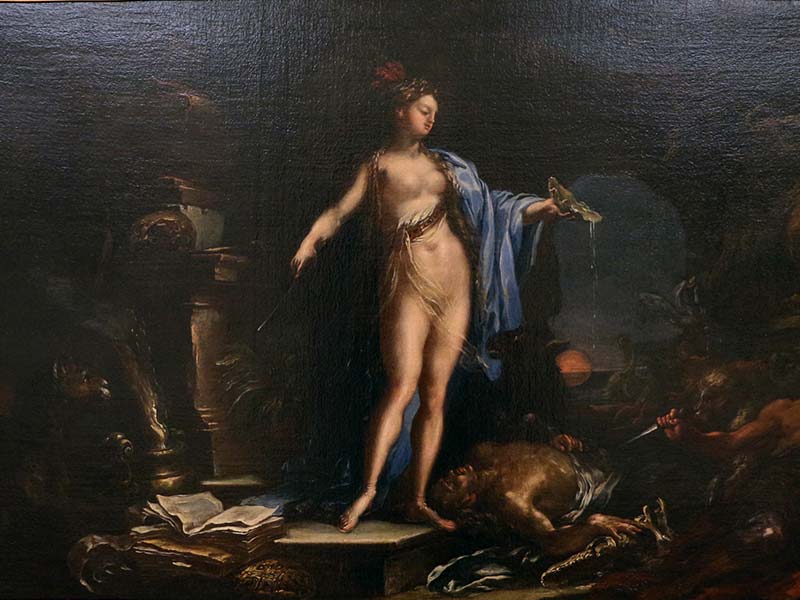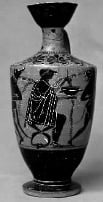di Sarah Perini
Adapted from Marija Gimbutas - Twenty years of Goddess study - Proceedings of the conference of the same name – Rome 9-10 May 2014 – Laima Editorial Project – Turin
Circe
Marconi recognizes in the figure of Circe and in that of Medea not only the most famous sorceresses of antiquity but goddesses, focusing her attention not on their possible humanity, but on their divine aspects. For her they are: "goddesses as sorceresses and sorceresses as goddesses, since magical virtue is the foundation of all the powers of the great Mediterranean deity".
The figure of Circe was brought to Italy by peoples of Mediterranean origin such as the Colchids, emigrating with them and finding acceptance in lands where similar figures already flourished. Circe is present both in the East and in the West and this is testified by the fact that the Aiaie and the Circei are found from Colchis to Italy, in Mesopotamia and according to Marconi also in India (Kerketai and Kolkhoi Indian peoples).
Il Kyrkaion polypharmakon it is the Italian Mount Circeo on which Circe's medicinal herb garden grows. The Kirkaion Pedion instead it is the Circeo plateau in the Caucasian region of Colchis dedicated to the dying, where the figure of Circe was that of Lady of Death next to Hecate.
Hague is an ancient Greek city in Thessaly irrigated by the Axios River which runs through Greece and Macedonia, the word “threshing floor” it took on the meaning of irrigated and fertile land and the adjective was born "barnyard" Circe's epithet: “the Goddess and Sorceress of the Fertile Land”; In the end, Farmyard it became a toponym indicating "the Island of Circe", the place where she lived in her garden of healing herbs.
Marconi associates Circe and Medea, by similarity of characteristics and origin from the ancient Mediterranean substratum, with more properly Italic figures such as Feronia, Angizia, Bona Dea Diana, Marica and also with Artemis.
All these figures shared: lordship over land, plants, animals; they guaranteed healing to their people through the use of herbs from their secret garden within the wood; lordship over serpents; being goddesses, sorceresses, women, wise priestesses; the ability to change the shape of themselves and of men; the relationship with parents or heroes, any relationship with blood relatives; being eponymous deities of lands and peoples; the being Lord of life and death.
Morgana
The limit of the territorial extension to the north of the figure of the Mediterranean Goddess analyzed by Marconi is the British Isles, the time limit is the Middle Ages; in the figures of the sorceresses and priestesses, of Morgana and the Lady of the Lake, she rediscovers the complexity of attributes and the autonomous and accomplished power of the Mediterranean matriarchy which in Pestalozza's words we remember to be: "more than authority, a matriarchy of intuition, understanding and multiple prestige”.
In the goddess Danu of the Celtic, Irish, Pictish and proto-British peoples, present with the name of Ana, Anu, Anna throughout Ancient Europe and in the Middle East, both Marconi and Gimbutas find the Goddess with the characteristics of Mother and Potnia; she guarantor of the passages of sovereignty and of the prudent management of the earth, also through the sacred marriages that took place between her priestesses and the new “kings for a year”, evolution of the “green man”, ancient companion of the Mediterranean Goddess.
Morgana is the Great Queen and Sorceress, connoisseur of healing herbs, sister of King Arthur, powerful lady who decides politics, life and death, free to choose her parents among the best knights of the Round Table, even among blood relatives, Shapeshifter, Lady of the Isle of Avalon, magical island of death and resurrection, where she resides in her secret garden.
Viviana is instead the Teacher of Knowledge, teacher-mother of the priestesses of the Isle of Avalon, her companion is the druid Merlin; she is the Lady of the Lake, a connoisseur of healing herbs who resides beside a lake in a forest dedicated to the goddess Diana, or more correctly Danu.
I personally believe that Circe, Medea, Morgana, Viviana and other more or less famous priestesses and sorceresses of antiquity were not goddesses as Marconi claims (while Potnia, Isthar, Hathor, Diana were) but women who wore the symbols and practices of the ancient Mediterranean Goddess; this differentiation is important to understand how women really lived in those times and had the same powers and responsibilities as the goddesses they honored. For this in my text: Symbols and rites of Celtic women, queens and goddesses at the time of Arthur, I also analyze these figures from a historical as well as a symbolic and literary point of view.
Conclusions:
Re-knowing the Goddess to be Women in the construction of the present.
What M. Marconi and M. Gimbutas certainly looked to from the Europe in which they lived, destroyed by the two world wars and by the patriarchal system, was how to recognize and re-build that Mediterranean Area and that Ancient Europe that had so bravely and acutely Seen with their gaze of Wise Women.
A challenge for the present may be to expand not only intellectual research, but also to propose new viable paths for the social and for sacred practices.
Today we young women have the duty not to interrupt the passage of the torch which from the hands of Marija Gimbutas continues to those of Joan Marler, from those of Jane Harrison to those of Momolina Marconi who offers it to Luciana Percovich who hands it to all of us researchers and women here today and to the mothers, sisters, daughters, women of the world who walk in the paths of the Goddess.
In conclusion, what we must ask ourselves while researching our past is what awareness does the discovery bring us that our Ancestors lived in a world in which the Goddess and women, men, animal and vegetable creatures, mother earth were honoured, respected, valued and resources wisely managed, and like today we can still bring the Sacred Feminine concretely to the center of our lives.
Sarah Perini
Adapted from Marija Gimbutas - Twenty years of Goddess study - Proceedings of the conference of the same name – Rome 9-10 May 2014 – Laima Editorial Project – Turin
REFERENCES
- Momolina Marconi – Mediterranean reflections of the most ancient Lazio religion – text available online on Filarete – website of the University of Milan Faculty of Letters and Philosophy;
- Momolina Marconi – edited by Anna de Nardis – From Circe to Morgana – written by Momolina Marconi – Venexia Editions;
- Sarah Perini – Symbols and Rites of Celtic Women. Queens and Goddesses in Arthur's Time – Ed. Psiche2 – reissued by Edizioni Ester.




